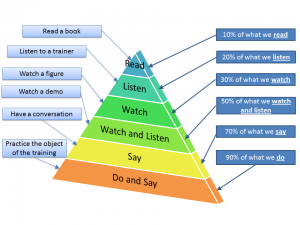Dale’s Cone of Experience
Dale’s Cone of Experience is a model that incorporates several theories related to instructional design and learning processes. During the 1960s, Edgar Dale theorized that learners retain more information by what they “do” as opposed to what is “heard”, “read” or “observed”. His research led to the development of the Cone of Experience. Today, this “learning by doing” has become known as “experiential learning” or “action learning”.
According to Dale’s research, the least effective method at the top, involves learning from information presented through verbal symbols, i.e., listening to spoken words. The most effective methods at the bottom, involves direct, purposeful learning experiences, such as hands-on or field experience. Direct purposeful experiences represents reality or the closet things to real, everyday life.
The cone charts the average retention rate for various methods of teaching. The further you progress down the cone, the greater the learning and the more information is likely to be retained. It also suggests that when choosing an instructional method it is important to remember that involving students in the process strengthens knowledge retention.
It reveals that “action-learning” techniques result in up to 90% retention. People learn best when they use perceptual learning styles. Perceptual learning styles are sensory based. The more sensory channels possible in interacting with a resource, the better chance that many students can learn from it. According to Dale, instructors should design instructional activities that build upon more real-life experiences.
Dales’ cone of experience is a tool to help instructors make decisions about resources and activities. The instructor can ask the following:
- Where will the student’s experience with this instructional resource fit on the cone? How far is it removed from real-life?
- What kind of learning experience do you want to provide in the classroom?
- How does this instructional resource augment the information supplied by the textbook?
- What and how many senses can students use to learn this instructional material?
Does the instructional material enhance learning?
Article taken from https://www.etsu.edu/uged/etsu1000/…/Dales_Cone_of_Experience.pdf
References:
Diamond, Robert M. Designing and Improving Courses and Curricula in Higher Education. San Francisco, Jossey-Bass, 1989.
Dale, Edgar. Audio-Visual Methods in Teaching, 3rd ed., Holt, Rinehart & Winston, New York, 1969, p. 108
Bruner, Jerome S. Toward a Theory of Instruction, Harvard University Press, Cambridge, MA, 1966, p. 49.